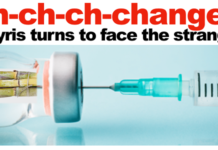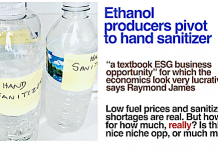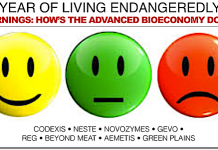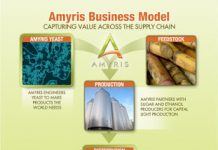Jim Lane

IIn California, American Refining Group has committed to a 33.3% equity investment into Novvi , a joint venture of Amyris (AMRS) and Cosan (CZZ). Both Amyris and Cosan will continue to hold share ownership stakes in Novvi, together with ARG.
It’s not a tiny market by any means.
The global markets for base oils and lubricants, are expected to reach $42 billion and $70 billion in size, respectively, by 2020, according to Amyris.
For ARG: Why Novvi, why now?
Think novel performance. It goes in two directions. First, there’s low-carbon performance customers want sustainable solutions. Then, there’s product performance customers are looking for increased durability in high-performance base stocks and lubricants. The new partners said that “a novel, performance-based, technology platform that couples segment-specific, top-tier performance with sustainable, bio-based feedstocks delivers against the needs of the industry today and in the future.”
For Amyris: why ARG, why now?
“This agreement is the first of several we expect this year where we are divesting from non-core marketing activity,” said Amyris CEO John Melo, “while remaining key technology developers and producers of high performance chemistry.”
Getting off a high-carbon product lifestyle
Those who follow consumer brand trends or discussions thereof, of who have run the Paris Climate Agreement numbers on a hand calculator, can tell you that carbon transition may be slow, it may be incremental, but it is coming and there is no turning back. The questions in low-carbon transition, today, are of speed, method, and which sectors go first.
Two options, generally. One is a mandate-led transition, like light bulbs, power and road fuels. The other is a brand-led transition, as happens with plastics, jet fuels and clothing. Amyris’ No Compromise branding encourage transitions not yet subject to mandates for high-margin, smaller-volume markets like flavors, fragrances nd lubricants.
Why No Compromise, instead of Less Carbon? Take, for example, a transition many are familiar with from the health space, reducing sugars out of a diet. Doesn’t change the need for finished foods for which sugar is a key ingredient. We might try the low-caloric sugars, such as Splenda or Equal. Generally, performance is incredibly important to us, and we’d like to get the same performance at the same price. But sweet must be sweet. Which is to say, the first step is performance.
It would be very intriguing to see branding that communicates hard targets on carbon transition as well as they communicate performance targets through messaging like “No Compormise”. In the fuels sector, we’ve seen the emergence of the below50 brand, that communicates a hard target of 50 percent carbon reduction.
These are branding strategies that will drive faster transition and better results for the companies in the nearer term. If consumers opt for “higher carbon reduction numbers” like they opt for higher-performance sunscreen (see our chart below, on how higher SPF sunscreens are growing much faster than the low-SPFs) why, that intensifies the speed of the carbon transition.
What does ARG do?
American Refining Group converts hydrocarbon feedstocks into high-quality waxes, lubricant base oils, gasoline and fuels, and specialty products.ARG’s Bradford, Pennsylvania refinery, founded in 1881, is the oldest continuously operating refinery in North America. Base oils are blended with additives to make the engine oils and lubricants sold on the market today.
More on ARG here.
Reaction from the partners
“Our launch of Novvi’s synthetic base oils has been embraced by manufacturers in a range of top-tier lubricant segments, across both automotive and industrial applications,” stated Jeff Brown, Novvi LLC’s CEO. “Our partnership with American Refining Group will help accelerate our growth by providing the necessary resources to ensure manufacturing, supply, and delivery capabilities to scale our business for volume and to meet customer expectations.”
“ARG’s Bradford refinery was built on innovation and market leadership in 1881, and this is an opportunity for ARG to lead the market once again this time with a renewable product,” stated ARG CEO Tim Brown. “The potential benefits cut across our base oil, finished lubricants, solvents, and drilling fluids businesses.”
Comments from industry observers
“Renewable oils offer customization of specs and performance that differentiate them from conventionally produced oils,” said Pavel Molchanov, senior vice president and equity research analyst at Raymond James. “A renewable oil that competes on performance and price is well positioned for the multibillion dollar lubricant and base oils market.”
“If a company could make the same quality PAO with a different feedstock, they could dramatically change the market. Customers would run to them,” said Joe Rousmaniere, director of business development at Chemlube International.
The Novvi backstory
Last summer we reported that Novvi unveiled two new 100 percent renewable base oil products, a 100 percent renewable polyalphaolefin (PAO) Group IV and a 100 percent renewable version of its NovaSpec Group III+ base oil. Both will be manufactured at the company’s production facility in Houston. Specifically, according to Transparency Market Research, Group IV & V Lubricants (PAO, PAG and Esters) Market – Global Industry Analysis, Size, Share, Trends and Forecast, 2012 – 2018,” the Group IV & V lubricants demand was 624.6 kilo tons in 2011 and is expected to reach 752.9 kilo tons in 2018, growing at a CAGR of 2.76% from 2013 to 2018.
Novvi’s 100 percent renewable PAO is a clean, direct replacement for conventional Group IV PAO base oils derived from petroleum and natural gas.
Who’s the customer?
“We work with customer-facing strategic partners in both, the base oil business and the finished lubricant side,” Novvi CEO Jeff Brown told The DIgest. “We’re doing the manufacturing now but we have a variety of partnership structures with customers, and we will scale production through strategic industry partnerships.”
More about Novvi
The Digest’s 8-Slide Guide to Novvi is here.
Jim Lane is editor and publisher of Biofuels Digest where this article was originally published. Biofuels Digest is the most widely read Biofuels daily read by 14,000+ organizations. Subscribe here.








